Tent Caterpillars

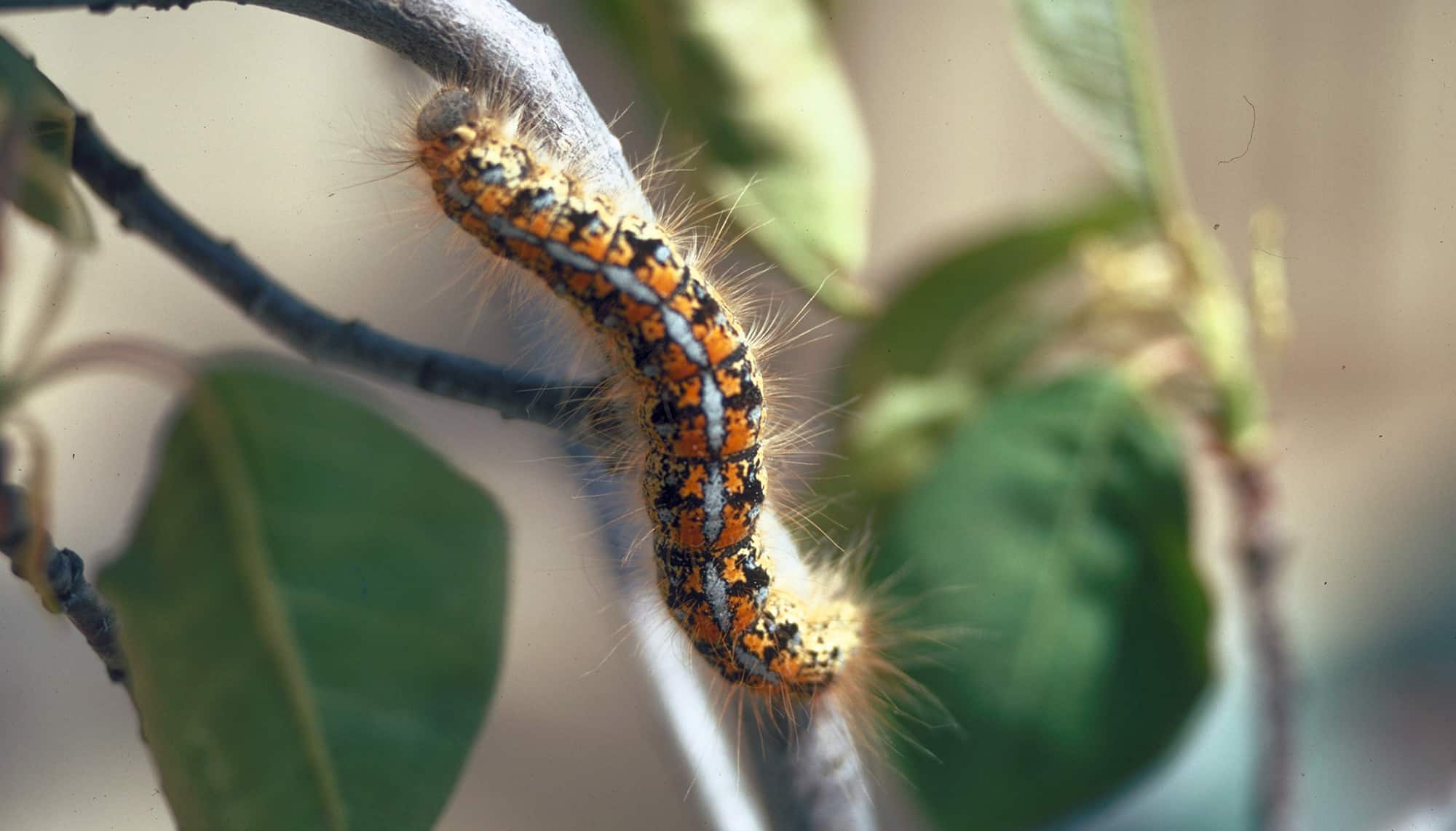
The Tents are Coming—No Cause for Alarm
Caterpillars signify new, rejuvenating life
By: Virgene Link-New, Skagit County WSU Extension Master Gardener
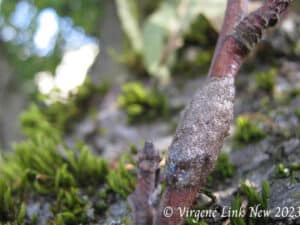
Egg case. © Virgene Link-New
Perhaps it is our fatigue, our weariness with the darkness of winter. Or maybe it’s our eagerness to see the lush new green of spring bursting forth that fuels our distress and disappointment over the early spring appearance of caterpillar tents in our trees.
Do not despair. Those tents are a sign of another type of life bursting forth: one that will replenish soil over-watered by winter rains and feed many species who have suffered from hunger during the winter. Those tents indicate the under-appreciated western tent caterpillar, Malacosoma californicum. There is also a forest tent caterpillar that is less common, Malacosoma disstria. The first is our most common tent maker in this region. Others are called webworms or tussock moths.
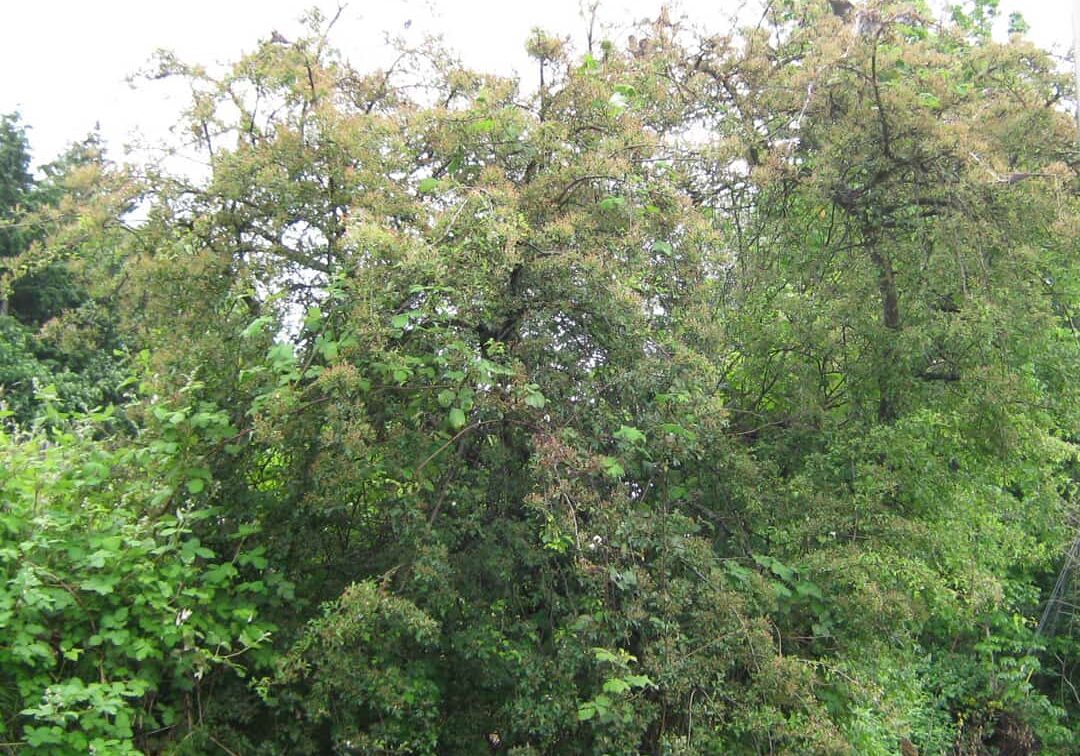
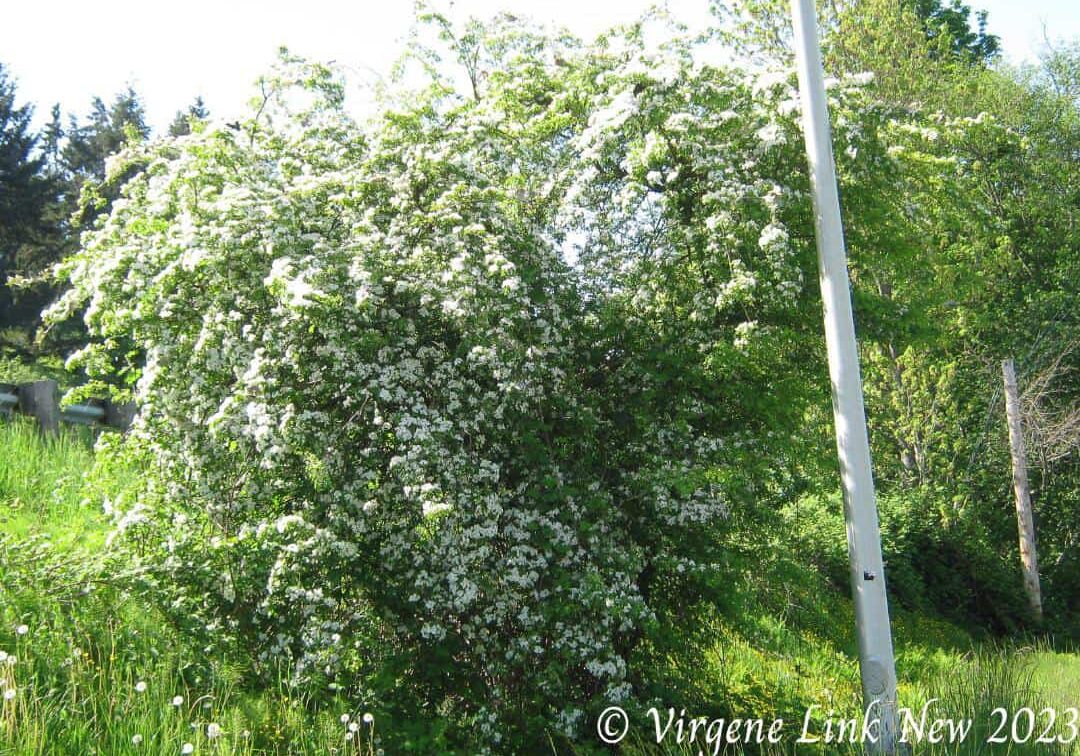
Their egg cases were deposited on deciduous trees and shrubs last year in the late summer and early fall. An egg case is many eggs “glued” together to form a “mass.” In the case of the tent caterpillar, it looks like a silvery Styrofoam mass when fresh. As the temperature warms, the eggs begin to hatch. The newly emerged hatching caterpillars spin a silken web to provide themselves with some protection from predators and weather. At first, they feed inside the tent, then they enlarge their tent as they grow. Since these caterpillars feed in early spring, the young leaves they consume are essentially recycled into compost that rains down to replenish the soil. The host tree has enough time to grow new leaves after the caterpillars have departed. Often, you see caterpillar tents in trees that later fail to develop. This is probably due to weather or other factors like disease or fungus.
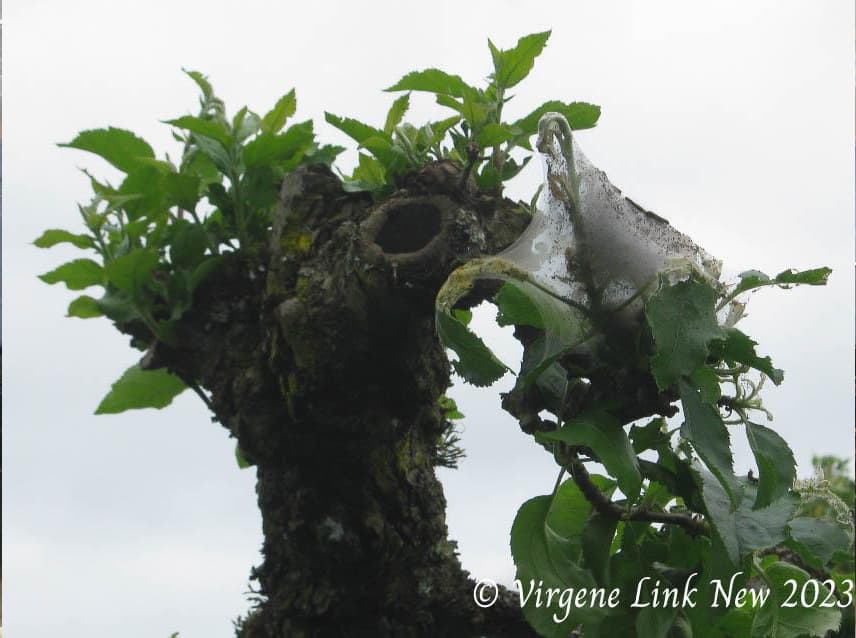
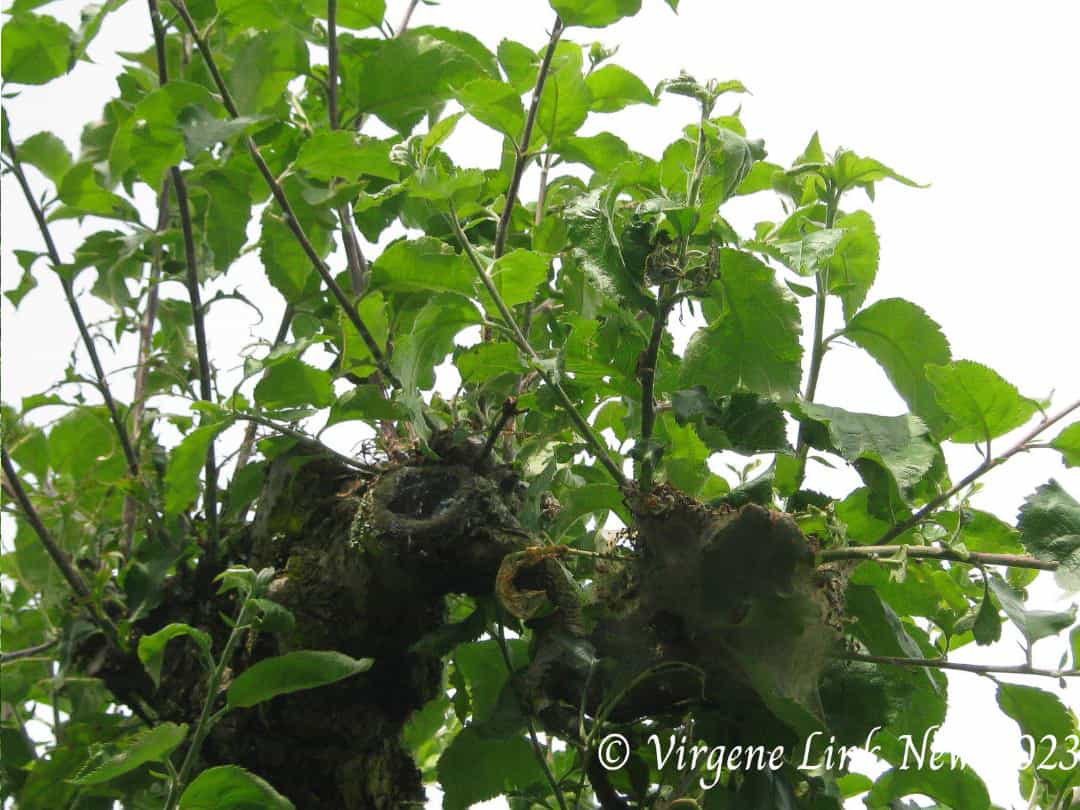
As they grow, the caterpillars eventually leave the tent and wander about, searching for more leaves to eat and a place to spin a cocoon. They undergo complete metamorphosis, the process of changing from an immature form to an adult form. At this time, they are more easily preyed upon by other insects, spiders, birds, small mammals, reptiles, and amphibians. Even their cocoons can be food for other species. Once they have emerged as moths to mate, they are more easily consumed by birds and bats. They are also vulnerable to viruses, diseases, and fungi.
Now, if you are in business and your livelihood depends upon fruit production or tree production, then action is necessary as energy is spent on producing more leaves. Also, the tents can interfere with setting of fruit. Orchardists act in the winter to remove the egg cases by peeling them off or pruning them out of the branches. The removed egg cases can be harmlessly dropped directly on the ground, which makes them available to predators like ground beetles and centipedes and allows any natural enemies whose parasitized eggs have been deposited in the egg case to exit!
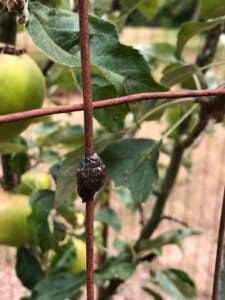
Tent caterpillar egg sack on fence © Pascale Michel
If you have a small, just-planted tree, you should do the same action as the orchardist since unestablished trees are more vulnerable to stress. Or an ornamental tree by your front door would be aesthetically displeasing with tents, and you might want to take some action in that case. If you’ve missed the window for removing the egg cases, the web with caterpillars inside can be pulled off or pinched when cool or in the evening if pruning would distort your desired shape. These mechanical removal methods are more environmentally friendly than the use of pesticides and do not result in chemical run off during rainfall that eventually reaches Puget Sound. As a reminder, please do not use a torch to burn the tents, as fire is more damaging to the plant than defoliation.
Larger trees will put out new leaves and should be less vulnerable to attack the following year as they seem to develop some resistance. Weakened trees are partially killed only when severe infestations (total defoliation) are combined with drought or other stressors (like disease). In forests where trees are too overcrowded for nutrients and moisture, this is a form of natural thinning.
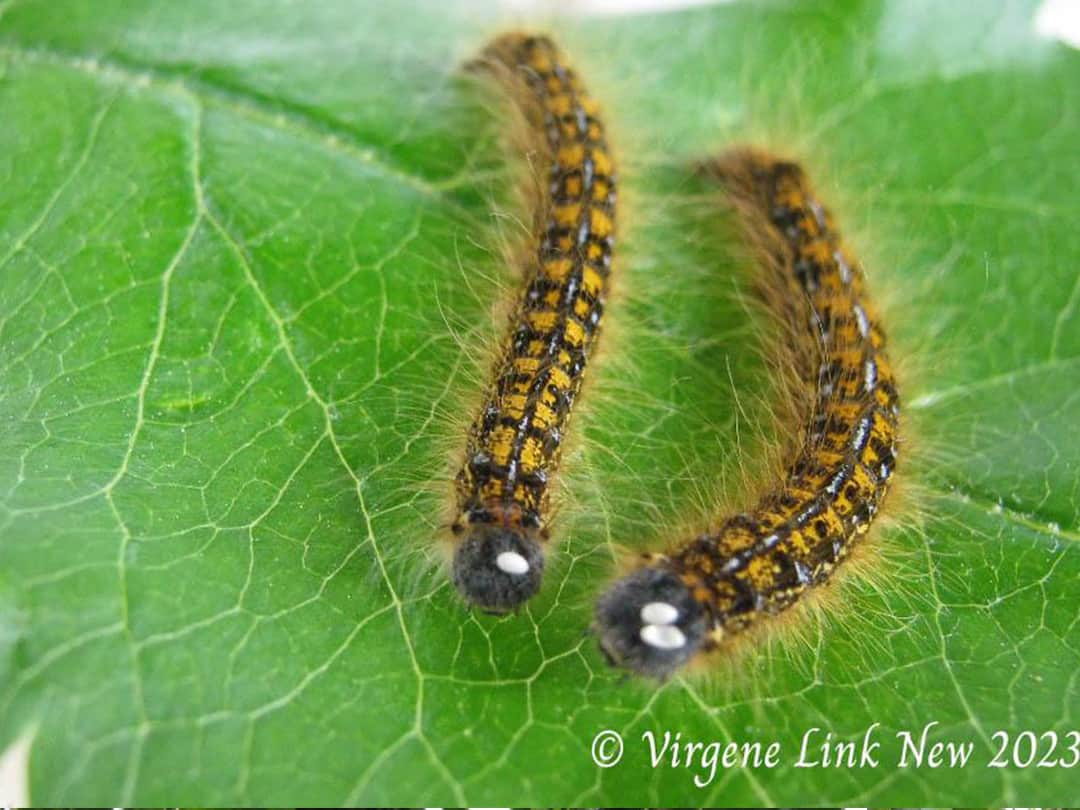
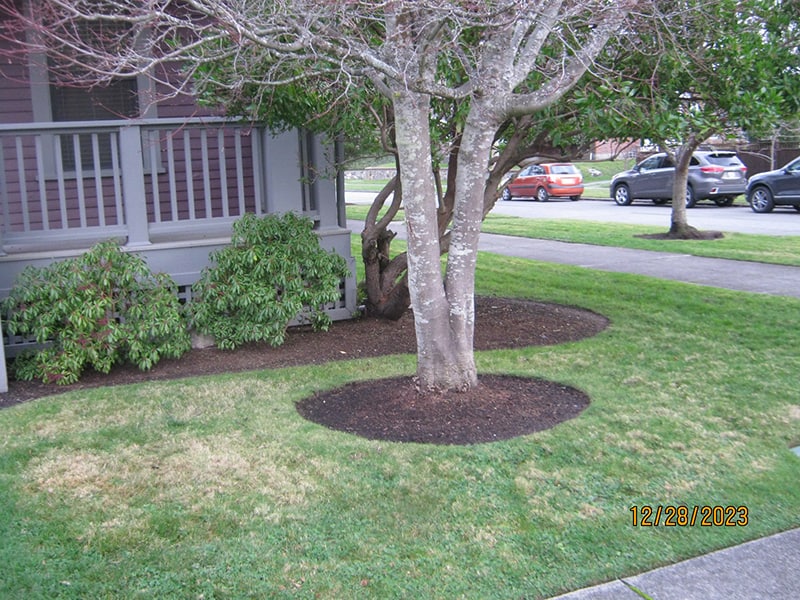
These past several years, the Pacific NW has been impacted by drought. Although tent caterpillars do not impact conifers (evergreens), their obvious dead tops in our landscape indicate that our trees suffer from a lack of water.
To protect the trees in your landscape, ensure they receive at least one inch of water per week out to the drip line. This is one reason the WSU Extension Master Gardener program recommends not having grass or plantings directly under your tree. You can use a moisture meter to read the depth to which water (rainfall or supplied) is reaching.
Our native trees have evolved with our native insects and thus have a symbiotic relationship that benefits the entire food web. Particularly, the tent caterpillar seeks out red alder in the native forest. Other host plants are those in the rose, birch, and willow families, to name a few.
Later in the year, we hardly notice the trees that hosted tent caterpillars, as we’ve forgotten which trees were defoliated in the abundance of new leaves. Please be tolerant of some damage because this species plays an important role in the ecosystem.
REFERENCES AND RESOURCES:
Eighme, L. (2009) Insects of Skagit County, Skagit County Master Gardener Foundation, pp17-18 & p124. https://www.skagitmg.org/wp-content/uploads/Public Pages/Library/Insects_of_Skagit_County_Eighme_2022.pdf
Colman, S., Antonelli, A., Murray T. “Tent Caterpillars” Washington State University Extension, December 5, 2022. https://hortsense.cahnrs.wsu.edu/fact-sheet/4377/
Tallamy, D. (2019) Bringing Nature Home, Updated and Expanded: How You Can Sustain Wildlife with Native Plants. Timber Press, Portland, Oregon
Western Tent Caterpillar, U.S. Forest Service, 2011.
https://www.fs.usda.gov/Internet/FSE_DOCUMENTS/stelprdb5303047.pdf
Drought Information and Resources. Washington State Department of Agriculture
https://agr.wa.gov/departments/land-and-water/natural-resources/water-quantity/drought-infoThe Ultimate Guide to Mulching Around Trees. The Eco Tree Company, Madison, WI. April 21, 2021.
https://ecotreecompany.com/how-to-put-mulch-around-a-tree/
Bruner, J. (1993) Tent Caterpillar, WSU Fruit Tree, Washington State University
https://treefruit.wsu.edu/crop-protection/opm/tent-caterpillar/
Tent Caterpillar IMP Strategy Fact Sheet
https://www.seattle.gov/documents/Departments/SPU/SWAC/TentCaterpillarIPMFactSheet.pdf
Koszarek, L. (2023) Moths: The Forgotten Pollinators. Penn State Extension Master Gardener, College of Agricultural Sciences, Penn State University, University Park, PA Retrieved at: Moths-The Forgotten Pollinators
Upcoming Skagit Master Gardener Foundation Events:
Master Gardeners at SICBA Home & Garden Show
March 22 - 24 at the Skagit County Fairgrounds
Visit our booth, see our displays, and talk with master gardeners about how to make your garden more beautiful and productive. Learn about free events and programs for home gardeners in Skagit County.
Food Innovation - Food Waste Prevention - Free
April 6, 9 AM to 12PM at the Port of Skagit
Celebrate Food Waste Prevention Week. Check out the worm composting bin, attend food waste prevention classes. Talk to the Skagit Gleaners. The WSU Breadlab sale starts at 10 AM. Event held at the Extension Office on 11768 Westar Lane, Burlington.
Know & Grow: Growing Roses in Skagit County – Free
April 16, 1 PM at the NWREC Sakuma Auditorium (16650 State Route 536; Mount Vernon) Presented by Virgene Link-New
Skagit County Master Gardener Plant Fair - Free
May 11, 8 AM to 2 PM at the Skagit County Fairgrounds
Learn More >
 ABOUT THE AUTHOR :
ABOUT THE AUTHOR :
Virgene Link-New has been a Skagit County WSU Extension Master Gardener since 2006. She is an avid insect collector and is garden manager of the Rose Garden in the Discovery Garden on SR 536 west of Mount Vernon.
Questions about home gardening or becoming a Master Gardener may be directed to: Skagit County WSU Extension Office, 11768 Westar Lane, Suite A, Burlington, WA 98233; by phone: 360-428-4270; or via the website: www.skagit.wsu.edu/mg
I live in Anacortes and they have hatched out. Tiny little caterpillars and tents.
Found a colony of what appears to be small tent catapillars, all dead and desiccated. 05/18/2024
Any thoughts? I have a picture but didn’t see how to attach it to this post.
Hello Carl: There are a couple of hypothses as to why you found a colony of small dead/dessicated caterpillars.
As they grow they shed their skins (exoskeletons) and then become larger. You may have found a small tent with exoskeletons as the caterpillars have moved on. They may also have succumbed to a virus or fungus that entered their nest.